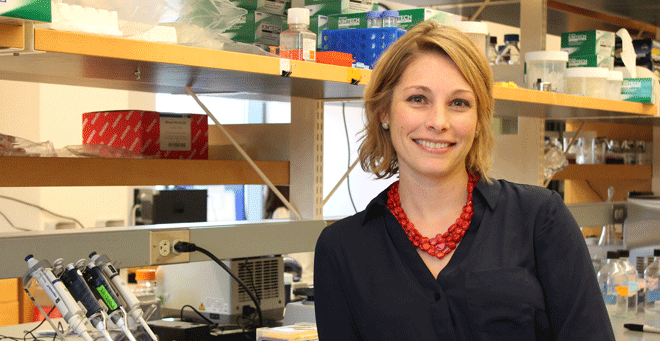 |
|
|
Dorothy P. Schafer, PhD |
Researchers at UMass Medical School have discovered a possible link between microglia function and the end stages of Rett Syndrome, according to a new study published Tuesday in eLife. Dorothy P. Schafer, PhD, assistant professor of neurobiology, and colleagues found that microglia, the resident central nervous system macrophages, contribute secondarily to Rett in animal models by dismantling synaptic circuits; in essence, the microglia are overeating weakened synapses late in the disease.
This finding could be therapeutically relevant in that targeting microglia in the late stages of Rett could potentially improve function and later life outcomes. However, it also shows that treating Rett may not be as simple as, for example, doing gene therapy on this one cell type, Dr. Schafer said.
Microglia are among the most recent cell types implicated in Rett pathogenesis. Schafer and a team of researchers from UMMS, Boston Children’s Hospital, Harvard University and the Weizmann Institute of Science hypothesized that microglia-mediated synaptic remodeling could be abnormal in mouse models of neurodevelopmental disorders associated with aberrant brain wiring.
“The nervous system is very complex and involves a lot of different cell types, many of which have been implicated in Rett. Our data suggest that microglia contribute to the end stages of the disease by dismantling neural circuits rendered vulnerable by the loss of MeCP2 in other CNS (central nervous system) cell types,” Schafer said.
Rett Syndrome, a rare, genetic, X-linked neurodevelopmental disorder, is caused primarily by mutations in the gene encoding for MeCP2, an important epigenetic regulator found in most cells of the body. Schafer and colleagues focused on this gene in their research using a mouse model of Rett Syndrome that lacks this gene.
“This MeCP2 gene is a master regulator of gene transcription, so it could be affecting a number of different things. Understanding more about how each cell on a mechanistic level contributes to the disorder will help us understand how to approach things therapeutically,” Schafer said.
Related story on UMassMedNow:
Schafer lab works to unlock mystery of microglia function